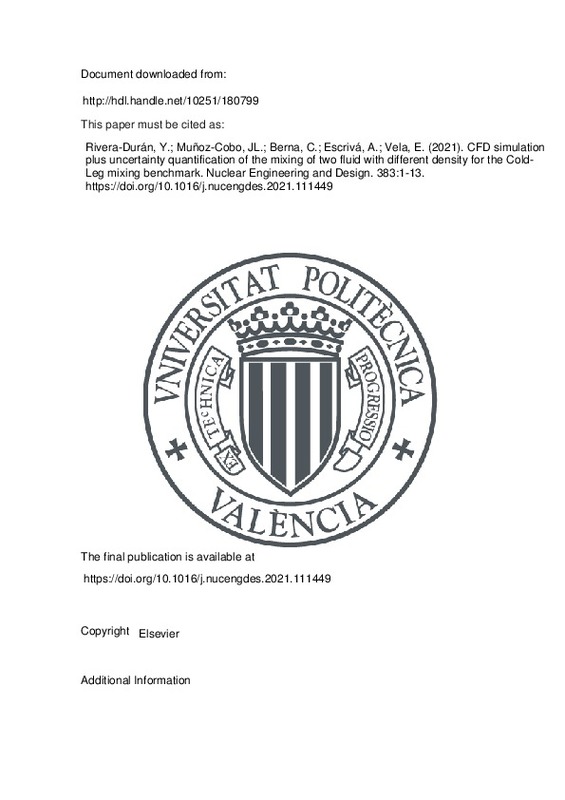JavaScript is disabled for your browser. Some features of this site may not work without it.
Buscar en RiuNet
Listar
Mi cuenta
Estadísticas
Ayuda RiuNet
Admin. UPV
CFD simulation plus uncertainty quantification of the mixing of two fluid with different density for the Cold-Leg mixing benchmark
Mostrar el registro sencillo del ítem
Ficheros en el ítem
| dc.contributor.author | Rivera-Durán, Yago
|
es_ES |
| dc.contributor.author | Muñoz-Cobo, J. L.
|
es_ES |
| dc.contributor.author | Berna, C.
|
es_ES |
| dc.contributor.author | Escrivá, A.
|
es_ES |
| dc.contributor.author | Vela, E.
|
es_ES |
| dc.date.accessioned | 2022-02-14T19:02:41Z | |
| dc.date.available | 2022-02-14T19:02:41Z | |
| dc.date.issued | 2021-11 | es_ES |
| dc.identifier.issn | 0029-5493 | es_ES |
| dc.identifier.uri | http://hdl.handle.net/10251/180799 | |
| dc.description.abstract | [EN] This document describes the details of the simulations and uncertainty quantification of the Cold-Leg Mixing benchmark performed at the Institute for Energy Engineering (Polytechnic University of Valencia, Spain). The experiment, carried out by Texas A&M University, consists of the mixing of two water flows with different densities inside two tanks joined by a pipeline or cold leg. The tank that accumulates the low-density water and its connection to the cold leg are designed to create a downcomer like the one found in a PWR reactor vessel. On the other hand, the high-density water reservoir represents the cold-water injection accumulator. The method of Polynomial Chaos Expansion (PCE) based on Gaussian Quadrature is applied to calculate the uncertainty of the results, and a model created in Ansys CFX is developed to carry out the simulations. A 5th order Polynomial Chaos Expansion by Gaussian-Hermite Quadrature has been applied using as uncertain parameter the density difference between the mixing fluids. Therefore, five simulations have been done for both the open and the blind test. This methodology aims to provide an efficient solution since PCE solved by Gaussian Quadrature allows to obtain uncertainty quantification through a low number of simulations when the amount of uncertain input variables is low. It has been observed that the turbulence model significantly affects the results obtained, being the LES model the only one able to reproduce the real behavior consistently. Simulation results show a good agreement with experimental data for the cold-leg measurement zone while, in the downcomer a slightly different velocity profile than the one measured experimentally is obtained. The concentration profile of each fluid shows a gap in the transition zone that does not seem to agree with the velocity results. That behavior remains for higher time averages when comparing simulation results with experimental measurements. | es_ES |
| dc.description.sponsorship | This work was supported by the project THAIS co-financed by the CSN (Nuclear Safety Council of Spain) and the UPV (Polytechnical University of Valencia) . The authors would also like to acknowledge the Texas A&M University for the experimental measurements, the OECD/NEA for organizing the benchmark and all the participants who make it possible. | es_ES |
| dc.language | Inglés | es_ES |
| dc.publisher | Elsevier | es_ES |
| dc.relation.ispartof | Nuclear Engineering and Design | es_ES |
| dc.rights | Reserva de todos los derechos | es_ES |
| dc.subject | Computational fluid dynamics | es_ES |
| dc.subject | Uncertainty quantification | es_ES |
| dc.subject | Polynomial chaos expansion | es_ES |
| dc.subject | Cold-leg mixing | es_ES |
| dc.subject | Benchmark | es_ES |
| dc.subject.classification | INGENIERIA NUCLEAR | es_ES |
| dc.subject.classification | ESTADISTICA E INVESTIGACION OPERATIVA | es_ES |
| dc.title | CFD simulation plus uncertainty quantification of the mixing of two fluid with different density for the Cold-Leg mixing benchmark | es_ES |
| dc.type | Artículo | es_ES |
| dc.identifier.doi | 10.1016/j.nucengdes.2021.111449 | es_ES |
| dc.rights.accessRights | Abierto | es_ES |
| dc.contributor.affiliation | Universitat Politècnica de València. Departamento de Ingeniería Química y Nuclear - Departament d'Enginyeria Química i Nuclear | es_ES |
| dc.description.bibliographicCitation | Rivera-Durán, Y.; Muñoz-Cobo, JL.; Berna, C.; Escrivá, A.; Vela, E. (2021). CFD simulation plus uncertainty quantification of the mixing of two fluid with different density for the Cold-Leg mixing benchmark. Nuclear Engineering and Design. 383:1-13. https://doi.org/10.1016/j.nucengdes.2021.111449 | es_ES |
| dc.description.accrualMethod | S | es_ES |
| dc.relation.publisherversion | https://doi.org/10.1016/j.nucengdes.2021.111449 | es_ES |
| dc.description.upvformatpinicio | 1 | es_ES |
| dc.description.upvformatpfin | 13 | es_ES |
| dc.type.version | info:eu-repo/semantics/publishedVersion | es_ES |
| dc.description.volume | 383 | es_ES |
| dc.relation.pasarela | S\452118 | es_ES |
| dc.contributor.funder | Consejo de Seguridad Nuclear | es_ES |
| dc.contributor.funder | Universitat Politècnica de València | es_ES |







![[Cerrado]](/themes/UPV/images/candado.png)

